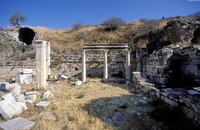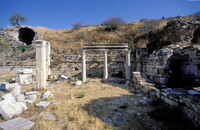| dc.coverage.spatial | Site: Ephesus, Aegean Region, Turkey | en_US |
| dc.coverage.temporal | ca. 60 BCE-60 CE (creation) | en_US |
| dc.creator | unknown (Ancient Roman) | en_US |
| dc.date | -60-60 | en_US |
| dc.date.accessioned | 2013-02-26T20:48:46Z | |
| dc.date.available | 2013-02-26T20:48:46Z | |
| dc.date.issued | -60-60 | en_US |
| dc.identifier | 196363 | en_US |
| dc.identifier.other | archrefid: 1560 | en_US |
| dc.identifier.uri | http://hdl.handle.net/1721.3/103874 | |
| dc.description | Ruins off the north end, east side; Remains of the Augustan period are more numerous: they include the aqueduct for the Marnas water supply; the Doric vestibule of the prytaneion with the Hestia hall; the double temple next to the prytaneion; the west and south gates of the Lower Agora; the monument of Augustus and his grandsons; and the basilica in the Upper Agora, which has columns alternately in the Corinthian and Ionic orders, the latter with bull protomes. In the 1st century AD the intense building activity continued. Under Nero were built the east stoa of the Lower Agora, in the Doric order, and, in the Ionic order, the west end of the basilica, which projects into the Square of Domitian. Source: Grove Art Online; http://www.oxfordartonline.com/ (accessed 7/13/2008) | en_US |
| dc.format.medium | stone | en_US |
| dc.rights | © Scott Gilchrist, Archivision, Inc. | en_US |
| dc.subject | architectural exteriors | en_US |
| dc.subject | Augustus, Emperor of Rome, 63 B.C.-14 A.D. | en_US |
| dc.subject | Roman Empire | en_US |
| dc.subject | Cesar Augustus | en_US |
| dc.subject | Nero | en_US |
| dc.subject | Imperial (Roman) | en_US |
| dc.title | Basilica | en_US |
| dc.title.alternative | Ephesus: Basilica | en_US |
| dc.type | image | en_US |
| dc.rights.access | Licensed for educational and research use by the MIT community only | en_US |
| dc.identifier.vendorcode | 1A3-R-T-E-11-C4 | en_US |
| vra.culturalContext | Ancient Roman | en_US |
| vra.technique | construction (assembling) carving (processes) | en_US |
| vra.worktype | basilica | en_US |
| vra.worktype | excavation (site) | en_US |
| dc.contributor.display | unknown (Ancient Roman) | en_US |



